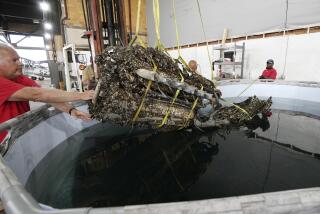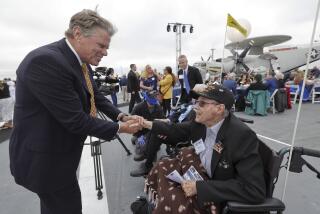Admiral Speaks From the Grave About Midway Battle : WWII: Vice Adm. Stanhope Cotton Ring lost 27 aircraft early in the conflict. A 22-page letter he wrote in 1946, recently discovered by his family, details what went wrong.
WASHINGTON — For decades, as chroniclers of the battle that turned the tide of World War II in the Pacific second-guessed Vice Adm. Stanhope Cotton Ring, his voice was silent. He had locked it away in his sea chest.
Now the Navy commander who lost 27 aircraft from a 60-plane squadron in the confusion of the early hours of the Battle of Midway speaks from the grave about what went wrong. It’s all there, in a 22-page handwritten letter dated March 28, 1946, and only recently discovered in a sea chest by his family.
“There has been much written about the Battle of Midway, and in many respects there has been a startling lack of accuracy,” begins Ring, who died in 1963. “This is an attempt, almost four years after the action, to set down in black and white my best recollections of what occurred.”
It was early on June 4, 1942, when Ring led his air wing from the carrier Hornet in one of the first forays against a four-carrier Japanese task force.
Of his 60 planes, 45 never saw the Japanese armada, and many ran out of fuel and crashed into the sea. The 15 that engaged the enemy, a squadron of slow and defenseless Devastator torpedo bombers flying without fighter protection, were picked off one by one by Japanese Zeros without making a single hit on the ships.
In addition to the 15 torpedo bombers, 10 fighters and two dive bombers were lost. The two fighter pilots and 29 of the 30 pilots and radio operators of the torpedo bombers died.
On returning to the Hornet, Ring found only 18 Douglas Dauntless scout bombers had made it back; 15 of the 17 dive bombers landed on Midway Island and later were able to return to action.
“I was shaken at the realization of such losses,” Ring wrote.
None of the major historians of the battle talked with Ring about his role, but their near-unanimous verdict was that his planes became lost. The line of reasoning held that his inability to attack in the battle’s crucial early hours caused greater American losses than necessary, including the carrier Yorktown.
Ring, the Hornet’s senior aviator whose air wing accounted for one-third of the strike force at Midway, admits to a mistaken assessment of a murky situation.
His letter makes clear, however, that “he was never lost at all,” said Navy Capt. Bruce Linder, who edited and annotated the letter for the Annapolis, Md.-based Naval Institute. “Those that jumped to that oversimplification lost the true significance of the complexity of the fledgling level of naval aviation in the early 1940s,” when navigation and communications methods were poor.
The “Lost Letter of Midway” was published in the U.S. Naval Institute’s “Proceedings” magazine this month.
Ring’s planes, along with the air group from the Enterprise, were to fly under radio silence to a location near Midway where the Japanese carriers were expected, with their planes away attacking U.S. installations at Midway. The undefended carriers would have been easy targets--if only they had been there.
When he didn’t see the carriers, Ring said he “decided that I should proceed on the assumption that the enemy was closing Midway and directed the course of the [planes] accordingly” toward the island. “My change of Air Group course to the south was based entirely on my estimate of the situation (which proved faulty) and not on definite information of the enemy movements.”
The Japanese had learned of the approaching American naval force and had turned to the northeast to find it, a 90-degree angle from Ring’s course.
Approaching Midway, Ring saw smoke but no enemy and decided “immediate return to the carrier was necessary . . . since fuel supply was running low.”
Ring picked up an unfamiliar homing signal--the code had been changed, and Hornet had not received word--and signaled his planes to ignore the beacon and return by dead reckoning. His scout bombers followed him, but the dive bombers and fighters did not. He tried to turn them back, “but I could not catch them.”
“When I finally gave up the chase, VS-8 had disappeared from sight and VB-8 was apparently headed for Midway,” he said of the plane groups.
His analysis of what went wrong --mainly communication problems and an inexperienced crew--agree with the evaluation of Adm. Chester W. Nimitz, the Pacific commander in chief, who wrote in his official report that the battle illustrated a need for better training for land and sea forces and more effective communication.
The torpedo bombers turned northward and chanced upon the Japanese carriers at roughly the same time as the Enterprise aviators.
Lt. Cmdr. John Waldron, commanding the Devastators, “courageously and in the face of certain destruction led his command in a torpedo attack against the enemy,” Ring wrote. By tying up the Zeros in defending their carriers against the torpedoes, Waldron’s attack allowed dive bombers from Enterprise to mortally wound three of the Japanese carriers.
The sole survivor of the Hornet torpedo crews was Ens. George Gay, a pilot who clung to a seat cushion as war swirled about him. He was picked up 30 hours later and reported having thought to himself during his ordeal: “It’s the end of the world, and I have a grandstand seat.”
Gay died four years ago, and his ashes were put into the Pacific on Aug. 31, 1995, at the spot where his comrades died 53 years earlier.
The Americans eventually prevailed at Midway.
During the three-day battle, an outnumbered U.S. force sank all four Japanese carriers and a heavy cruiser, put another cruiser out of action and destroyed more than 250 planes and some of the Japanese navy’s most experienced combat pilots.
The battle 1,100 miles west of Hawaii ended Japan’s early advance through the Pacific toward the American territory and put the Allies on course to Japan’s surrender on Sept. 2, 1945.
‘It’s the end of the world, and I have a grandstand seat.’
Ens. George Gay, the sole survivor of the Hornet torpedo crews who clung to a seat cushion as war swirled in the sea about him. Gay died four years ago, and his ashes were put into the Pacific at the spot where his comrades died 53 years before.
More to Read
Sign up for Essential California
The most important California stories and recommendations in your inbox every morning.
You may occasionally receive promotional content from the Los Angeles Times.










